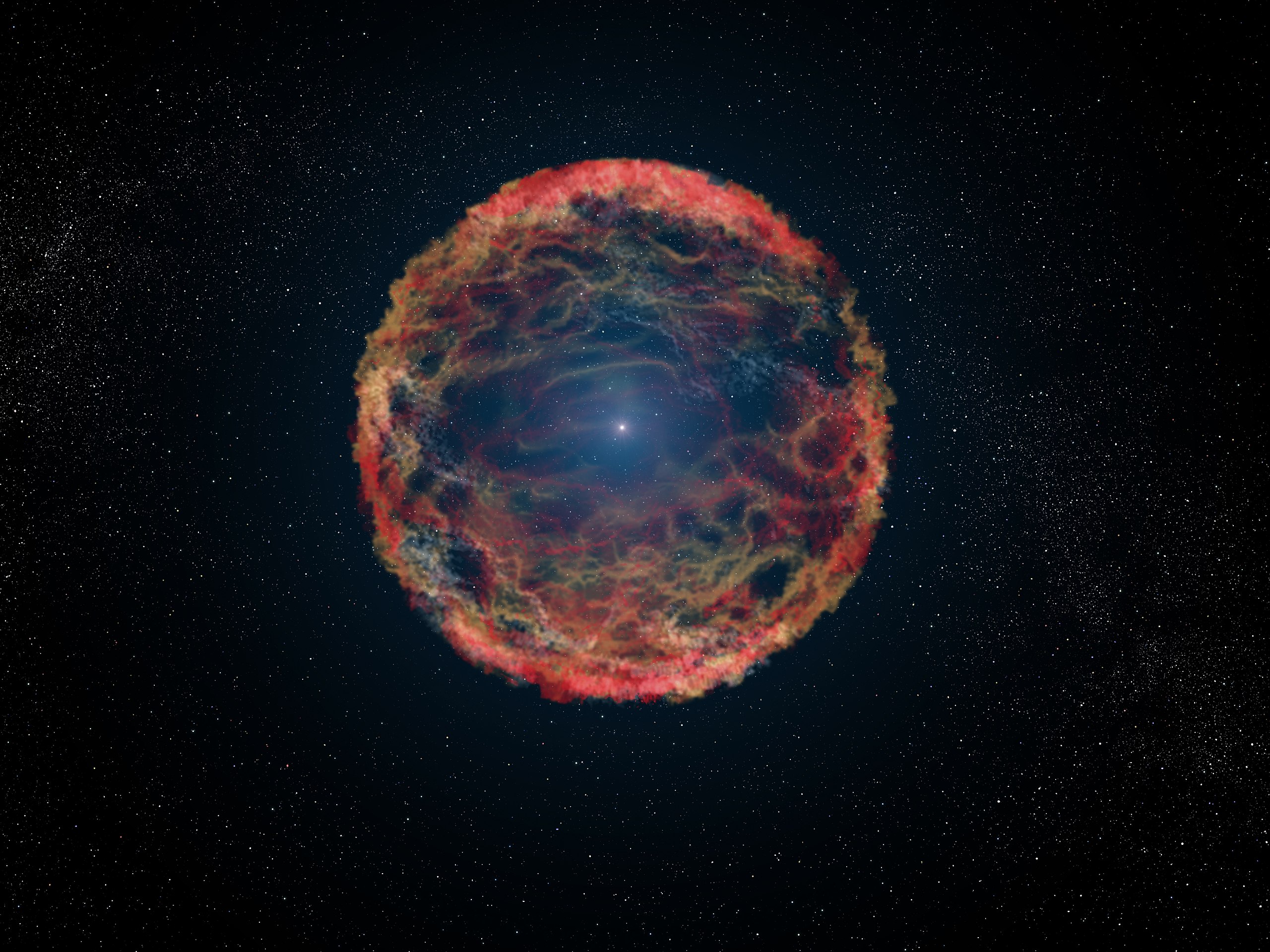
Artist's impression of the supernova 1993J, an exploding star in the galaxy M81. NASA, ESA and G. Bacon.
NASA's space telescope has managed to photograph, in a single image, a red giant star after its explosion in the early universe, more than 11 billion years ago
11 November 2022
ESA and NASA's Hubble Space Telescope has captured in a single snapshot three different moments after the explosion of a distant red supernova, which took place more than 11 billion years ago, when the Universe was still primitive at 2.1 billion years old. The paper containing this work, entitled "Shock cooling of a red-supergiant supernova at redshift 3 in lensed images", was published in the journal Nature.
An international team including the IFCA (CSIC-UC) researcher José María Diego has obtained the most precise images of a young supernova in the history of the Universe, which also show the first stages of a stellar explosion. Both findings could help the scientific community to learn more about the formation of stars and galaxies in the early universe.
"What is special about this finding is that we have observed the supernova during its first moments, which has only been possible with supernovae much closer to us," explains José María Diego, researcher at IFCA (CSIC-UC) and author of the paper. "My work has been to interpret the gravitational lensing effect and the relative delay times between the different images of the supernova," says Diego.
"It's quite rare that you can detect a supernova at a very early stage, because that stage is very short," says Wenlei Chen, first author of the research and a postdoctoral researcher at the School of Physics and Astronomy at the University of Minnesota. "It only lasts a few hours to a few days, and can easily go unnoticed even for close detection. In the same exposure, we were able to see a sequence of the images, like multiple faces of a supernova," he adds.
Hubble image showing the three moments of the supernova explosion behind the galaxy cluster 'Abell 370'. / STScI
The three faces of an explosion
The Hubble telescope has captured in a single image three unique moments of the supernova explosion through different phases, which reached Earth at the same time. This image was made possible thanks to a phenomenon called 'gravitational lensing': this effect is produced by a cluster of galaxies, with a mass thousands of times the mass of our Galaxy, which amplifies the light produced by objects that are far away and aligned just behind the cluster. It works like a lens would, magnifying the light reaching us from the supernova, making it visible to the space telescope.
In this way, the galaxy cluster Abell 370 has acted like a large lens, magnifying the light from this distant supernova, which was behind the cluster. And the images magnified by the lens have taken three different routes through the cluster, due to differences in the length of the paths the supernova light followed, the slowing of time and the curvature of space due to the gravity predicted by Albert Einstein.
"Because light takes different times to travel along these three paths, the Hubble image shows three instants of the explosion in a single image. Among these three instants, one of them corresponds to only a few hours after the explosion," explains Diego.
The red supernova
Hubble has also captured the temperature changes of the supergiant star, which can be seen by the variation in its colour. The bluer it is, the hotter the supernova is, and as the supernova cools, the redder its light becomes. "You see different colours in the three images," says Patrick Kelly, leader of the study and professor in the School of Physics and Astronomy at the University of Minnesota. "In the core of the massive star, you get a shock, it heats up, and then you see it cool down for a week. It's probably one of the most amazing things I've ever seen," he confirms.
500 times bigger than the Sun
The Hubble observations also show that this red supergiant star was 500 times the size of the Sun. This is the first time the research team has been able to measure the size of a dying star in the early universe. To do so, they have relied on machine learning algorithms to measure the brightness and cooling rate of the star.
Now, taking advantage of the arrival of NASA's James Webb Space Telescope, the team plans to start observing supernovae even more distant than this one, and to create a catalogue of supernovae that will help to understand whether the stars that existed billions of years ago are different from those in the universe we know today.
Rebeca García / IFCA Communication
